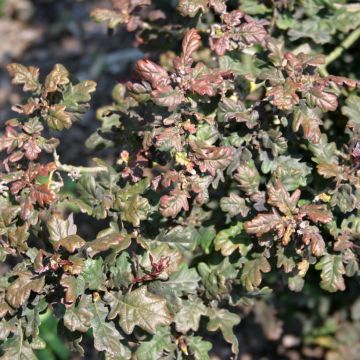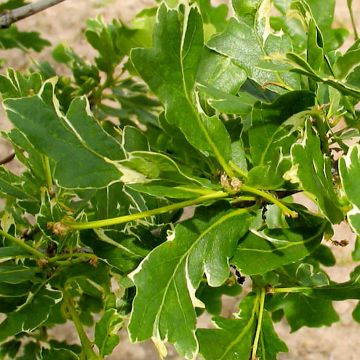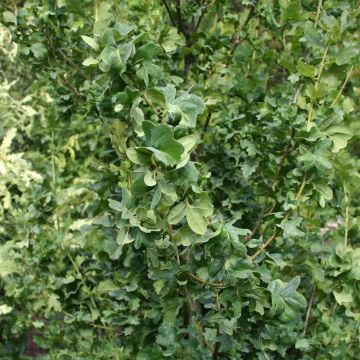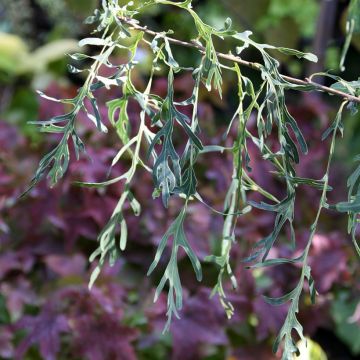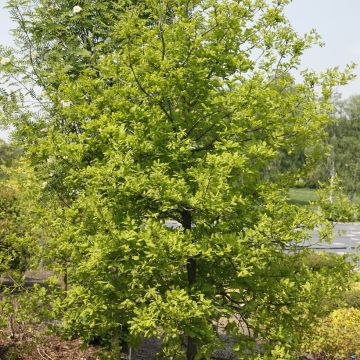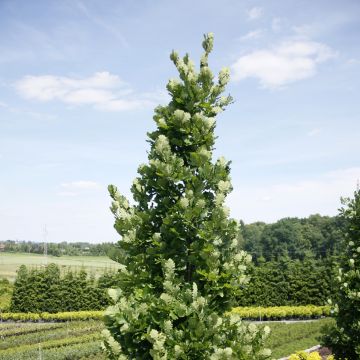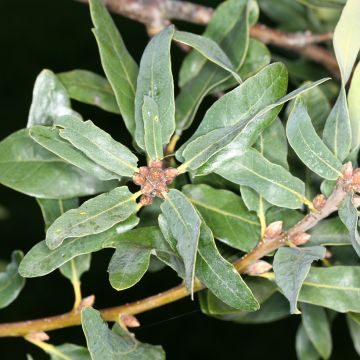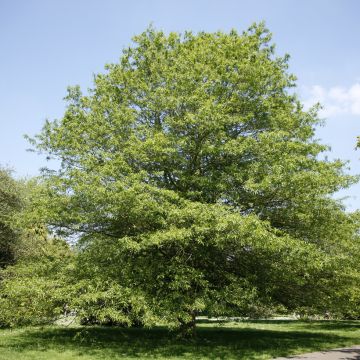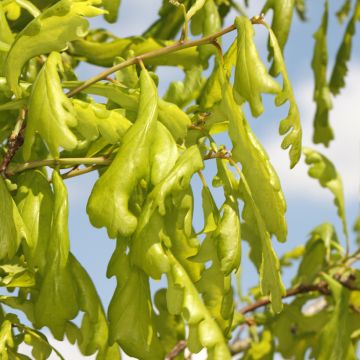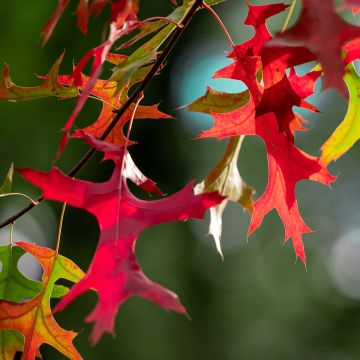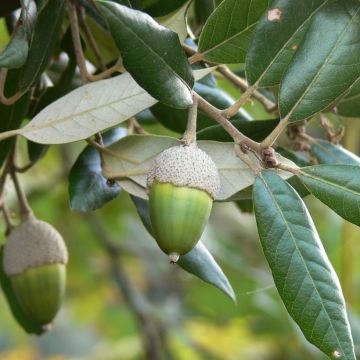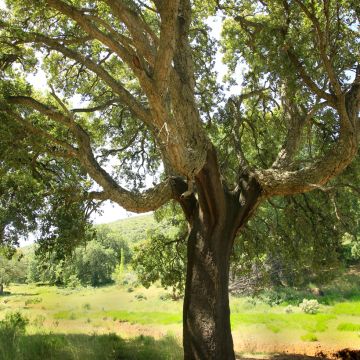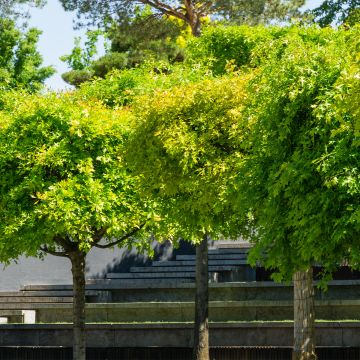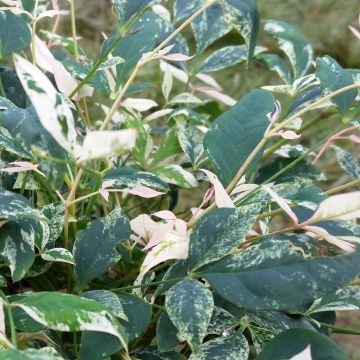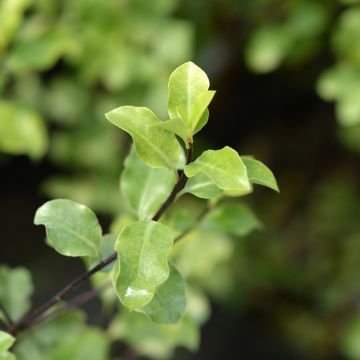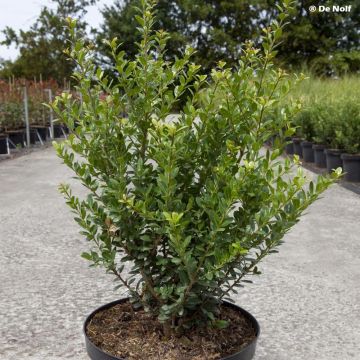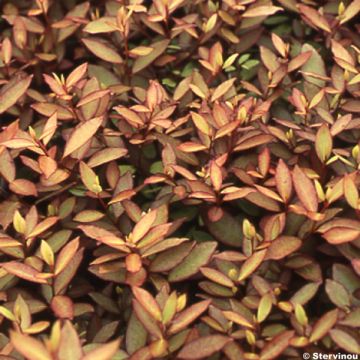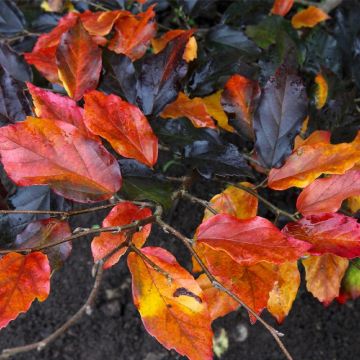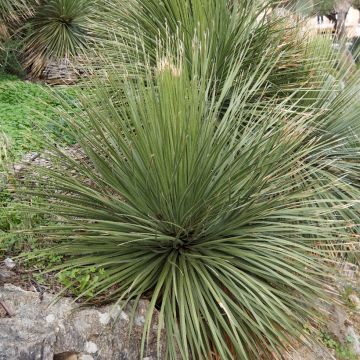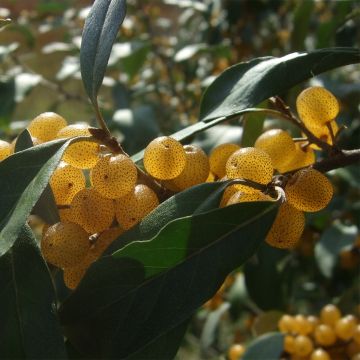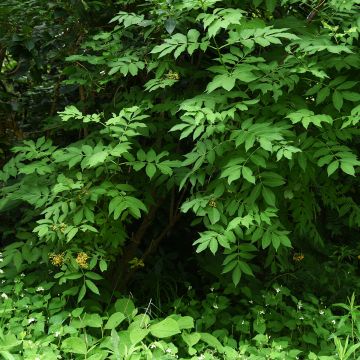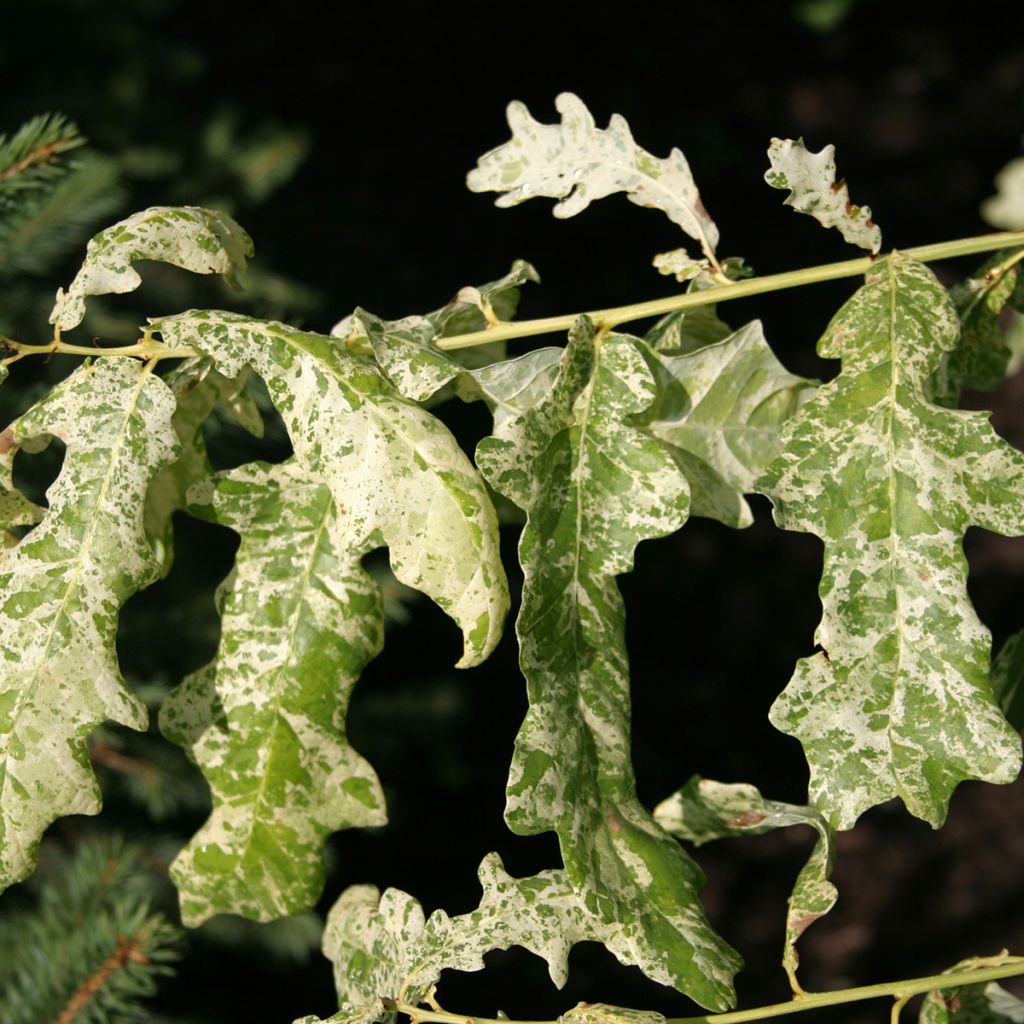

Quercus robur Jan Zamoyski - Oak
Quercus robur Jan Zamoyski - Oak
Quercus robur Jan Zamoyski
English Oak, Pedunculate Oak, European Oak
Why not try an alternative variety in stock?
View all →This plant carries a 24 months recovery warranty
More information
We guarantee the quality of our plants for a full growing cycle, and will replace at our expense any plant that fails to recover under normal climatic and planting conditions.
Does this plant fit my garden?
Set up your Plantfit profile →
Description
Quercus robur Jan Zamoyski is an old Polish selection of the pedunculate oak with variegated foliage, which reappeared on the market in the early 2000s. This beautiful tree, with relatively slow growth, is distinguished by its green leaves speckled with white. The large lobed leaves are initially variegated with yellow, which gradually turns white, giving a very bright aspect to the vegetation. This very hardy, unusual oak tree grows in most soils as long as they are sufficiently moist, as it does not like drought, which slows down its growth. Over time, it reaches a height of about twelve metres and is suitable for planting in isolation, in a sunny position, in a large garden.
The oak tree is a member of the Fagaceae family, like the beech and the chestnut tree with approximately 600 species worldwide, deciduous and evergreen, mainly in the northern hemisphere, in arid, temperate, or humid tropical climates. The Quercus genus particularly inspires collectors, as it is rich in diversity with species like the chestnut-leaved oak... There are approximately 240 named cultivars, such as Jan Zamoyski.
This variety, originally introduced to the market in 1903, has an original history. Selected by Feliks Rożyński, then director of the Podzameckie nurseries, owned by the Zamoyski family, he named it Jan Zamoyski in honour of a wealthy Grand Hetman of the Crown (the highest military title in Poland in the 16th century). Commercialised until 1938, its production ceased during the Second World War and it eventually fell into oblivion, until Bronisław Szmit, a Polish nurseryman, rediscovered and identified a surviving specimen in 2003.
Now available again, this variety deserves attention, as it is truly ornamental. This beautiful tree, slightly slower growing than the botanical species, also has a less imposing development. Over the years, it eventually reaches a height of about twelve metres (maximum 15 m under good conditions) and approximately 8 m in width or more. Its silhouette is essentially the same as that of the oak tree found in the countryside, it is mainly the foliage that differs. It bears large, very long, (20 to 25 cm), relatively narrow leaves, with 3 to 6 rounded lobes on each side, of irregular size. When they emerge, the leaves are speckled with yellow, then as they age, they become more leathery and the yellow turns to cream and then white. The young leaves are the most colourful, as they age, the proportion of green becomes predominant over white. Due to their size, the leaves borne on short petioles droop downwards. The bark of the young branches is a tender green, slightly yellow, and gradually darkens to become brownish-brown like the trunk bark. The rather insignificant flowering in spring produces the same acorns as the typical species.
This oak tree is extremely hardy, tolerating temperatures as low as -23°C to -26°C. It grows in full sun, also tolerating light shade without affecting its variegation. It is rather accommodating regarding soil pH, accepting moderately chalky to slightly acidic soils. However, it requires a certain level of humidity and humus-bearing soil to develop well.
Quercus robur Jan Zamoyski will delight enthusiasts of bright foliage. Ideally, it should be planted in front of a backdrop of dark green vegetation, such as conifers, to better enjoy its beautiful speckled variegation. It is very attractive and can be planted in isolation in the middle of a lawn, in a garden large enough to accommodate it. Other trees of similar size and with colourful foliage can accompany it, such as the Golden Honeylocust (Gleditsia triacanthos Sunburst). With its very graceful compound leaves, changing from golden to anise green before returning to orange-yellow in autumn, it will create a superb contrast with the oak tree. Liquidambar styraciflua Golden Sun, with its beautiful palmate leaves, golden in spring, turning green in summer before the autumnal blaze of carmine red tinged with purple, will also be an excellent companion. For an even stronger contrast, opt for Acer platanoides Crimson Sentry, a Norway maple with magnificent purple palmate leaves, turning coppery red in autumn.
Report an error about the product description
Quercus robur Jan Zamoyski - Oak in pictures
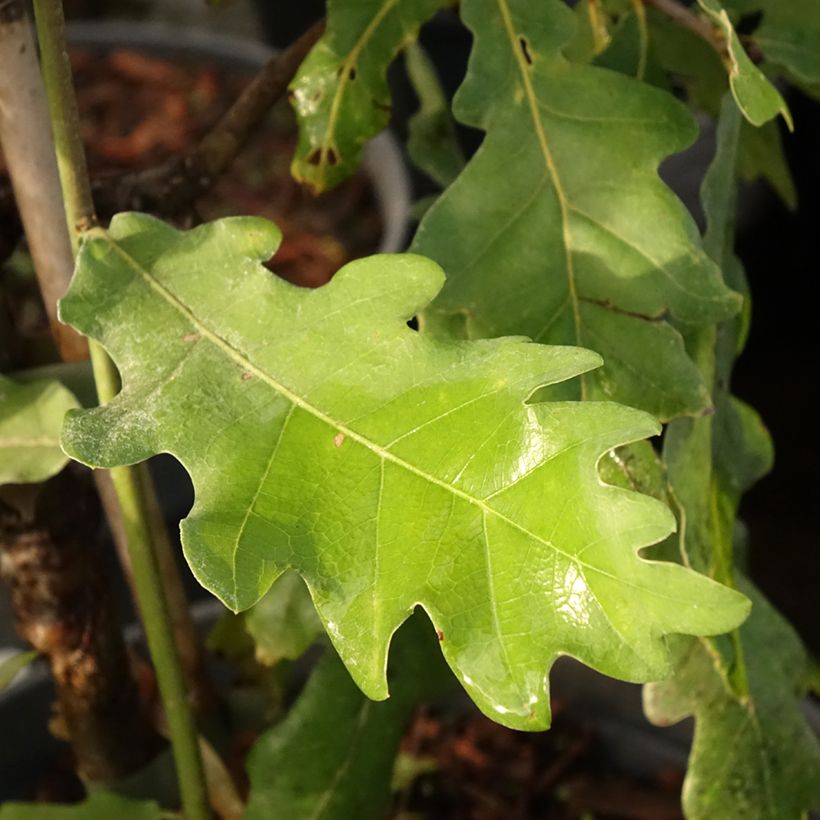

Plant habit
Flowering
Foliage
Botanical data
Quercus
robur
Jan Zamoyski
Fagaceae
English Oak, Pedunculate Oak, European Oak
Cultivar or hybrid
Other Oak
View all →Planting and care
Quercus robur Jan Zamoyski grows in ordinary but deep soil, remaining moist in depth, preferably clayey, slightly chalky, neutral or slightly acidic. It prefers fertile and humus-rich soils. Once established, this tree with deep anchorage can withstand normal summers and does not require any watering. It appreciates moist but well-drained soils, where its growth will be faster. In poor and dry soils, its growth will be slowed down. It prefers very sunny and well-cleared exposures, which promote remarkably colourful foliage. Soak the root ball in a bucket of water for a while to thoroughly saturate it before planting, put it in the planting hole, backfill around it and water abundantly. Place a sturdy stake to help it start, water for the first two years, then let nature take its course. It is a tree that, once established, requires very little maintenance except for the removal of dead wood. It is not very prone to diseases.
Planting period
Intended location
Care
-
, onOrder confirmed
Reply from on Promesse de fleurs
Similar products
Haven't found what you were looking for?
Hardiness is the lowest winter temperature a plant can endure without suffering serious damage or even dying. However, hardiness is affected by location (a sheltered area, such as a patio), protection (winter cover) and soil type (hardiness is improved by well-drained soil).

Photo Sharing Terms & Conditions
In order to encourage gardeners to interact and share their experiences, Promesse de fleurs offers various media enabling content to be uploaded onto its Site - in particular via the ‘Photo sharing’ module.
The User agrees to refrain from:
- Posting any content that is illegal, prejudicial, insulting, racist, inciteful to hatred, revisionist, contrary to public decency, that infringes on privacy or on the privacy rights of third parties, in particular the publicity rights of persons and goods, intellectual property rights, or the right to privacy.
- Submitting content on behalf of a third party;
- Impersonate the identity of a third party and/or publish any personal information about a third party;
In general, the User undertakes to refrain from any unethical behaviour.
All Content (in particular text, comments, files, images, photos, videos, creative works, etc.), which may be subject to property or intellectual property rights, image or other private rights, shall remain the property of the User, subject to the limited rights granted by the terms of the licence granted by Promesse de fleurs as stated below. Users are at liberty to publish or not to publish such Content on the Site, notably via the ‘Photo Sharing’ facility, and accept that this Content shall be made public and freely accessible, notably on the Internet.
Users further acknowledge, undertake to have ,and guarantee that they hold all necessary rights and permissions to publish such material on the Site, in particular with regard to the legislation in force pertaining to any privacy, property, intellectual property, image, or contractual rights, or rights of any other nature. By publishing such Content on the Site, Users acknowledge accepting full liability as publishers of the Content within the meaning of the law, and grant Promesse de fleurs, free of charge, an inclusive, worldwide licence for the said Content for the entire duration of its publication, including all reproduction, representation, up/downloading, displaying, performing, transmission, and storage rights.
Users also grant permission for their name to be linked to the Content and accept that this link may not always be made available.
By engaging in posting material, Users consent to their Content becoming automatically accessible on the Internet, in particular on other sites and/or blogs and/or web pages of the Promesse de fleurs site, including in particular social pages and the Promesse de fleurs catalogue.
Users may secure the removal of entrusted content free of charge by issuing a simple request via our contact form.
The flowering period indicated on our website applies to countries and regions located in USDA zone 8 (France, the United Kingdom, Ireland, the Netherlands, etc.)
It will vary according to where you live:
- In zones 9 to 10 (Italy, Spain, Greece, etc.), flowering will occur about 2 to 4 weeks earlier.
- In zones 6 to 7 (Germany, Poland, Slovenia, and lower mountainous regions), flowering will be delayed by 2 to 3 weeks.
- In zone 5 (Central Europe, Scandinavia), blooming will be delayed by 3 to 5 weeks.
In temperate climates, pruning of spring-flowering shrubs (forsythia, spireas, etc.) should be done just after flowering.
Pruning of summer-flowering shrubs (Indian Lilac, Perovskia, etc.) can be done in winter or spring.
In cold regions as well as with frost-sensitive plants, avoid pruning too early when severe frosts may still occur.
The planting period indicated on our website applies to countries and regions located in USDA zone 8 (France, United Kingdom, Ireland, Netherlands).
It will vary according to where you live:
- In Mediterranean zones (Marseille, Madrid, Milan, etc.), autumn and winter are the best planting periods.
- In continental zones (Strasbourg, Munich, Vienna, etc.), delay planting by 2 to 3 weeks in spring and bring it forward by 2 to 4 weeks in autumn.
- In mountainous regions (the Alps, Pyrenees, Carpathians, etc.), it is best to plant in late spring (May-June) or late summer (August-September).
The harvesting period indicated on our website applies to countries and regions in USDA zone 8 (France, England, Ireland, the Netherlands).
In colder areas (Scandinavia, Poland, Austria...) fruit and vegetable harvests are likely to be delayed by 3-4 weeks.
In warmer areas (Italy, Spain, Greece, etc.), harvesting will probably take place earlier, depending on weather conditions.
The sowing periods indicated on our website apply to countries and regions within USDA Zone 8 (France, UK, Ireland, Netherlands).
In colder areas (Scandinavia, Poland, Austria...), delay any outdoor sowing by 3-4 weeks, or sow under glass.
In warmer climes (Italy, Spain, Greece, etc.), bring outdoor sowing forward by a few weeks.



































